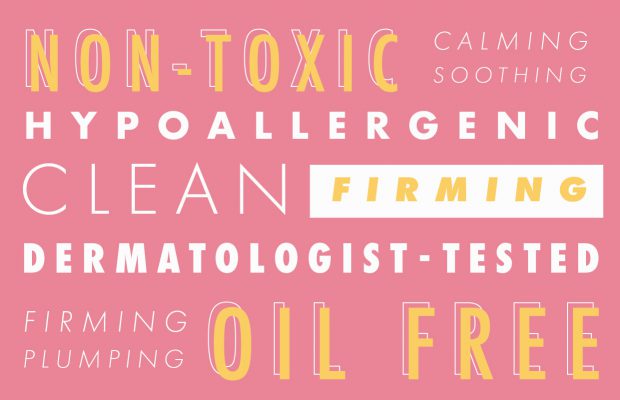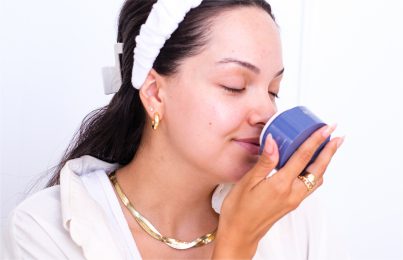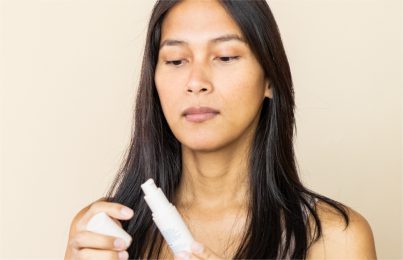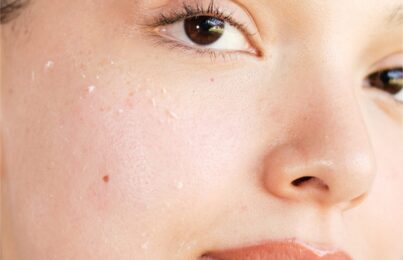The world of skincare marketing can be confusing, to say the least. With so many terms used to describe the products we buy, it can be hard to know what they really mean and how much stock we should be putting into them. In this post, my goal is to demystify some of the most common marketing terms found in skincare to help you become a smarter, more informed consumer. Let’s go!
Product Performance Terms
These are all common terms used to describe what a product will do for your skin. They have to do with the visible effect a product has on the skin.
Brightening
I’ve always viewed bright skin as skin with an even, uniform tone that’s free from hyperpigmentation or dark spots. Some people may also lump “glowing” in with brightening. Glowing refers to skin being light reflective and having good circulation.
There are three main ways a product can add brightness to the skin: 1) increase cellular turnover, 2) degrade melanin pigment within the skin for an overall more even skin tone, and 3) prevent excess melanin from being formed in the first place.
Some of the main brightening ingredients include exfoliating acids, vitamin C, and retinol.
Firming
There are a few ways a product can provide firmness to the skin. First, it can create a film over the skin that causes it to contract and become tighter. This gives the instant perception of firming. Skin also feels firmer when it’s hydrated because it will look plumper.
If you’re looking for more long-term firming effects, look to peptides. Peptides stimulate the production of collagen and elastin, which are two important structural components of firm skin. This is important because both begin to deplete as we age. You won’t see instant effects using peptides, but with consistent use, the benefits will be well worth it down the road!
Hydrating or Plumping
Hydration is a term that people use to refer to water content within the skin. When your skin is being hydrated, it’s taking on increased water content, which leads to a plumping effect. The best way to achieve this is to use humectants, which are a class of ingredients that attract water from the air and pull it into the skin. Effective humectants include hyaluronic acid and glycerin.
Calming or Soothing
This one probably resonates with you if you have redness in your skin or if your skin becomes easily inflamed when you try new products. Calming or soothing products typically contain anti-inflammatory ingredients that are meant to tackle visible redness as well as symptoms of inflammation such as burning or stinging. They help cool the skin down or, as I like to say, “put out the fire.”
There are tons of great calming ingredients out there, but one class of ingredients that’s really up and coming in this area is algae. I choose to formulate with red marine algae in my line and love it for its ability to soothe, protect, and strengthen the skin’s barrier.
Anti Aging
This one is a bit trickier because it’s really about prevention, so you don’t always see instant results. Because of this, I’d divide anti-aging products into two categories: those that give an instant boost and those that give results further down the road.
Some ingredients (in fact a lot of the ingredients mentioned above) instantly make your skin look better and, therefore, more youthful. If your skin looks brighter, smoother, or plumper, it makes you feel better instantly. On the other hand, you have ingredients that need to be used over long periods of time. You won’t see them working immediately but when used consistently they can actually prevent some of the visible signs of aging that would otherwise naturally appear. Read my beginner’s guide to using retinol or retinoids.
Consumer Preference
These terms all have to do with product classification and consumer preference. It can definitely be a confusing space because a lot of these don’t have legal definitions, but I’m here to help you navigate them!
Clean
“Clean” has no legal definition. It can vary from company to company and from person to person. What you consider clean really comes down to what you’re personally comfortable with, You have to find a brand you trust that resonates with that.
For example, some people feel silicones are clean because they have very pure chemistry and are unlikely to cause a bad reaction on the skin. Other people, however, may not feel silicones are clean because they tend to be synthetically processed, meaning they aren’t strictly raw materials (such as honey or other unprocessed foods).
Learn more about my thoughts on the clean beauty movement.
Non-Toxic
This is a skincare marketing term that’s especially problematic because labeling your product “non-toxic” implies that other brands may be formulating with toxins you’ve chosen to leave out. In reality, it’s illegal to put toxins into cosmetics in the U.S. I know a lot of people feel that the cosmetics industry in the U.S. is unregulated, but there are certain standards you must abide by to be a legitimate brand. If you’re following these standards, you’re formulating your products safely and are never using ingredients in a way that could be toxic to humans.
Most big beauty brands or conglomerates conduct safety assessments for their products by having a toxicologist review not only the final product, but each individual ingredient to make sure they’re being used properly and aren’t interacting with one another in a potentially harmful way. This toxicology testing is required in Europe but optional in the U.S., so the responsibility is on the brand to make sure their products are safe. Again, it’s important to buy from companies you trust!
Natural or All-Natural
This is definitely a confusing claim as it’s pretty open to interpretation. Much like “clean,” there is no legal definition for natural. When a brand makes this claim I’m often left wondering what they mean. Do they mean the raw materials they use aren’t processed? That they haven’t added anything from synthetic chemistry? Are they adding things from natural sources then chemically modifying them? It’s just not clear. If a brand identifies themselves or their products as natural or all-natural, it’s on them to explain what that means.
There is an international standard that is trying to become more mainstream for calculating the percent natural origin of a product. This standard takes into consideration the original ingredient, what chemistry has been applied (if any), and which ingredients are completely synthetic. The problem with this is that people automatically assume a product with a higher natural percentage is better or safer than something synthetic, and that’s not always the case. In fact, a lot of synthetic ingredients are used to make cosmetic products safer. The claim that something is natural can be very misleading when it’s used for marketing.
Organic
This is one of few claims that are highly regulated. It doesn’t speak to an entire product, but rather to the ingredients that make up a product. It speaks to the cultivation practice the ingredient undergoes and how it’s grown, cultivated, and processed.
In order to claim a product is organic, it has to contain a certain percentage of certified organic ingredients according to the USDA.
Fragrance-Free
This claim can be made when a product doesn’t contain any fragrance material at all. This includes synthetic perfumes, essential oils, and anything that is added specifically to provide a pleasant scent. This could even be a pleasant-smelling fruit extract.
Unscented
Unscented is a little different in that, while a product hasn’t been formulated to have a beautiful scent, it can still contain ingredients that have been added to neutralize unpleasant odors. So while these products don’t usually have much of a scent, they’re not technically considered fragrance-free.
Oil-Free
The term oil-free means just that—a product that literally doesn’t contain any oils. To get a little technical, oils are officially classified as any compound made up of triglycerides. This includes things like marula oil, almond oil, jojoba oil, etc.
That said, there are ingredients that aren’t made up of triglycerides but intrinsically still have an oily or greasy feel to them. A company can include these in a product and still claim it’s oil-free. There has actually been some recent litigation around this because some consumers have felt duped by the oil-free claim. Yes, the product may be free of triglycerides, but it can still contain other greasy-feeling ingredients that make consumers feel like they aren’t getting what they were looking for from an oil-free product.
Non-comedogenic
This is one that most people think they understand, but there still seem to be misconceptions. At its most basic level, comedogenicity is the likelihood something will cause comedones (clogged pores). Today, there are two methods used for comedogenic testing.
In the first method, a product or ingredient is applied to the skin on a person’s upper back. Over the course of hours and weeks, clinicians will check for an acne response and even take a small biopsy from the site to see if there are any comedones in the area. The problem with this test is that the skin on the back doesn’t translate directly to the skin on a person’s face, so it’s not the most accurate.
The second method is a clinical testing format where the results are evaluated by a board-certified dermatologist. Participants are graded on whether they already have mild, moderate, or severe acne lesions. The product or ingredient is placed on the skin over the course of four to six weeks after which the skin is evaluated for the number and type of lesions. This is then compared to the baseline.
The good thing about this test is that it uses a real-life model and translates much more directly to how people use products in real life. The drawback is that, when ingredients are tested for comedogenicity, they’re applied to the skin at 100 percent concentration. When an ingredient is used in a skincare product, it’s never at 100 percent, so this test doesn’t take into account how an ingredient will be formulated. What’s the delivery system? How does it interact with the other ingredients in the formula? None of this is taken into consideration, which is why the “comedogenicity scores” assigned to ingredients (which a lot of consumers look at) are not always realistic. Keep in mind that it’s very expensive to test an entire product for comedogenicity, so most brands just go off of individual ingredient scores. Learn more about skincare ingredient percentages.
Product Testing
These terms relate to how product claims are tested as well as product safety.
Hypoallergenic
In order for a company to claim their product is hypoallergenic (unlikely to cause an allergic reaction, so especially good for sensitive or reactive skin), it has to undergo what’s called human repeat insult patch testing or HRIPT.
It’s not a perfect test of course, because the number of subjects is limited, but the benefit is that it’s performed on actual human subjects. Basically, 100-200 people with different skin types are selected and the product is repeatedly applied to their skin. The subjects’ skin is then evaluated for a response to determine if the product is in any way irritating, sensitizing, or elicits an allergic reaction.
If the results are good, you can say your product is for sensitive skin. To claim that it’s hypoallergenic, you have to take it a step further and have the results reviewed by a dermatologist. This is where dermatologist-tested and dermatologist-approved come in.
Dermatologist-Approved
This comes from the HRIPT test mentioned above. During the test, you can say, “I want a dermatologist to review my report, and put a stamp on it.” That’s dermatologist-approved, and now a product can be labeled as such.
Another way to look at “dermatologist-approved” is if you have a dermatologist test the product themselves, or test the product with their patients. This is basically a form of consumer testing and means dermatologists have said, “This is a great product that we recommend to patients all the time.”
Dermatologist-Tested
Dermatologist-tested basically takes dermatologist-approved one step further. Instead of having a clinician conduct testing, such as an HRIPT, you would have a dermatologist overseeing it and making the final assessment. Another way to think of this is that a product has been dermatologist-reviewed.
Clinically-Tested
This is a claim-substantiation test, meaning it could be testing any number of marketing claims. The important thing about “clinically-tested” is that it means a company has had a third-party lab or consumer product testing facility do unbiased testing of their product.
For All Skin Types
For some brands, it’s important to have versatile products that can be used by people with a wide variety of skin types. There are a few ways a brand can get this claim for a product. The first option is clinical testing. In a clinical setting, the product has to be tested on a wide variety of skin types and monitored for any unwanted side effects. The second option is consumer product testing. To do this, a company needs to bring in a third-party organization that sends their product out to consumers and sets up the testing.
So there you have it! These are some of the most common skincare marketing terms and what they really mean. As you can see, it’s not always black and white. I hope this post offers some insight and makes you more confident about choosing the skincare products that are right for you.
Next, learn whether medical and professional-grade skincare products are really better.
Celebrity Esthetician & Skincare Expert
As an esthetician trained in cosmetic chemistry, Renée Rouleau has spent 35 years researching skin, educating her audience, and building an award-winning line of products. Her hands-on experience as an esthetician and trusted skin care expert has created a real-world solution — products that are formulated for nine different types of skin so your face will get exactly what it needs to look and feel its best. Trusted by celebrities, editors, bloggers, and skincare obsessives around the globe, her vast real-world knowledge and constant research are why Marie Claire calls her “the most passionate skin practitioner we know.”



